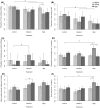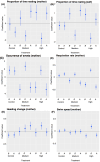Vessel noise levels drive behavioural responses of humpback whales with implications for whale-watching
- PMID: 32539930
- PMCID: PMC7324156
- DOI: 10.7554/eLife.56760
Vessel noise levels drive behavioural responses of humpback whales with implications for whale-watching
Abstract
Disturbance from whale-watching can cause significant behavioural changes with fitness consequences for targeted whale populations. However, the sensory stimuli triggering these responses are unknown, preventing effective mitigation. Here, we test the hypothesis that vessel noise level is a driver of disturbance, using humpback whales (Megaptera novaeangliae) as a model species. We conducted controlled exposure experiments (n = 42) on resting mother-calf pairs on a resting ground off Australia, by simulating whale-watch scenarios with a research vessel (range 100 m, speed 1.5 knts) playing back vessel noise at control/low (124/148 dB), medium (160 dB) or high (172 dB) low frequency-weighted source levels (re 1 μPa RMS@1 m). Compared to control/low treatments, during high noise playbacks the mother's proportion of time resting decreased by 30%, respiration rate doubled and swim speed increased by 37%. We therefore conclude that vessel noise is an adequate driver of behavioural disturbance in whales and that regulations to mitigate the impact of whale-watching should include noise emission standards.
Keywords: anthropogenic noise; behavioural response; cetacean; controlled exposure experiment; ecology; humpback whale; unmanned aerial vehicle.
Plain language summary
Whale-watching is a multi-billion-dollar industry that is growing around the world. Typically, tour operators use boats to transport tourists into coastal waters to see groups of whales, dolphins or porpoises. There is, however, accumulating evidence that boat-based whale-watching negatively affects the way these animals behave and so many countries have put guidelines in place to mitigate activities that may disturb the animals. These guidelines generally stipulate the boat’s angle of approach, how close the boat can get and the speed at which it can pass by the animals. In general, these guidelines are based on the assumption that the animals are disturbed by the closeness of the whale-watching boats. However, whales, dolphins and porpoises have very sensitive hearing, and only have a short range of vision underwater. Therefore, it seems plausible that the animals hear whale-watching boats long before they see them and so the loudness of underwater noise from the boats may be enough to disturb these animals' behaviour. To test this hypothesis, Sprogis et al. performed experiments where they simulated a whale-watching vessel approaching humpback whale mothers and calves who were resting off the northwest coast of Australia. A small motorised research boat travelling at a low speed passed different mother-calf pairs at a target distance of 100 meters, which is a common whale-watching distance guideline in many countries. The boat had an underwater speaker that played recordings of the boat noise at different volumes, while a drone with a video camera flew overhead to record the whales’ behaviours in detail and to identify individual animals. These “controlled exposure experiments” showed that the quiet boat noise did not appear to disturb the mothers and calves. However, compared to when the quiet boat passed the animals the louder boat noise decreased how long the mother whale rested on the surface by 30%, made her swim 37% faster, and doubled the number of breaths she took per minute. If there are many disturbances from humans, then it can negatively impact the energy the mother and calf have available for nursing, fending off males and predators, and migrating back to their feeding ground nearer the Earth’s poles. Based on these findings, it is shown that the loudness of the underwater noise from boats can explain why whales may be disturbed during whale-watching activities. To help reduce this disturbance, Sprogis et al. recommend that noise emission standards should be added to the current whale-watching regulations such that boats should be as quiet as possible and ideally around the volume of the ambient background noise. This would allow operators to approach the animals in a responsible, sustainable manner and offer tourists a view of undisturbed wildlife.
© 2020, Sprogis et al.
Conflict of interest statement
KS, SV, PM No competing interests declared
Figures











References
-
- Argüelles MB, Coscarella M, Fazio A, Bertellotti M. Impact of whale-watching on the short-term behavior of southern right whales (Eubalaena australis) in Patagonia, Argentina. Tourism Management Perspectives. 2016;18:118–124. doi: 10.1016/j.tmp.2016.02.002. - DOI
Publication types
MeSH terms
Associated data
Grants and funding
LinkOut - more resources
Full Text Sources
Miscellaneous

